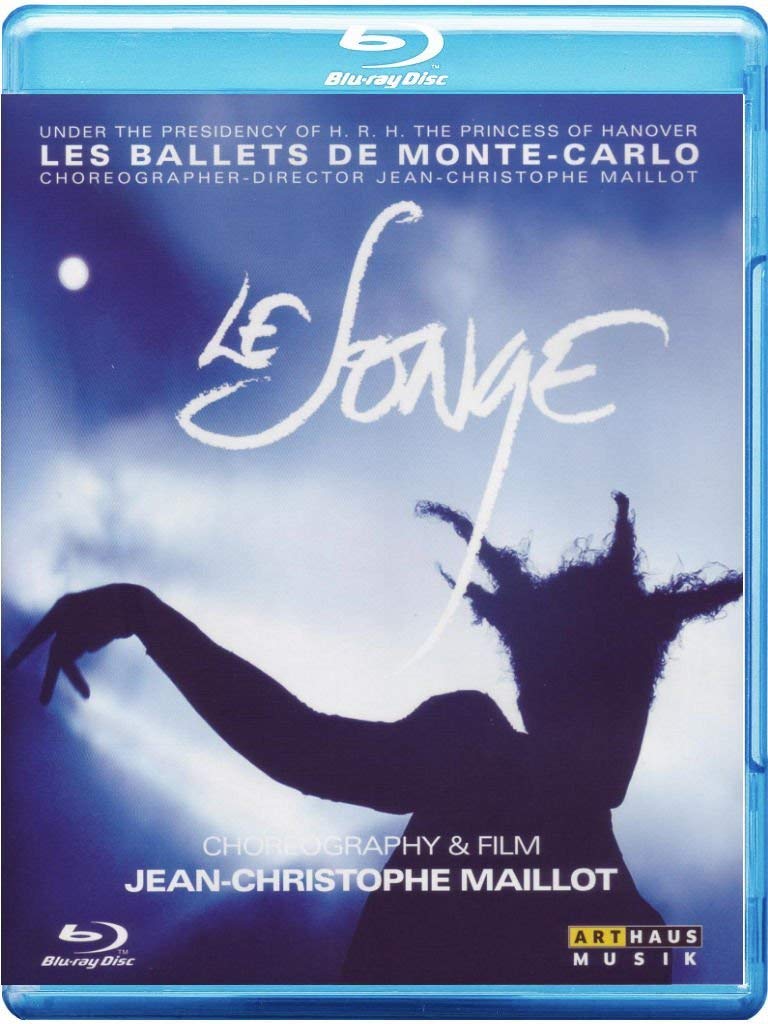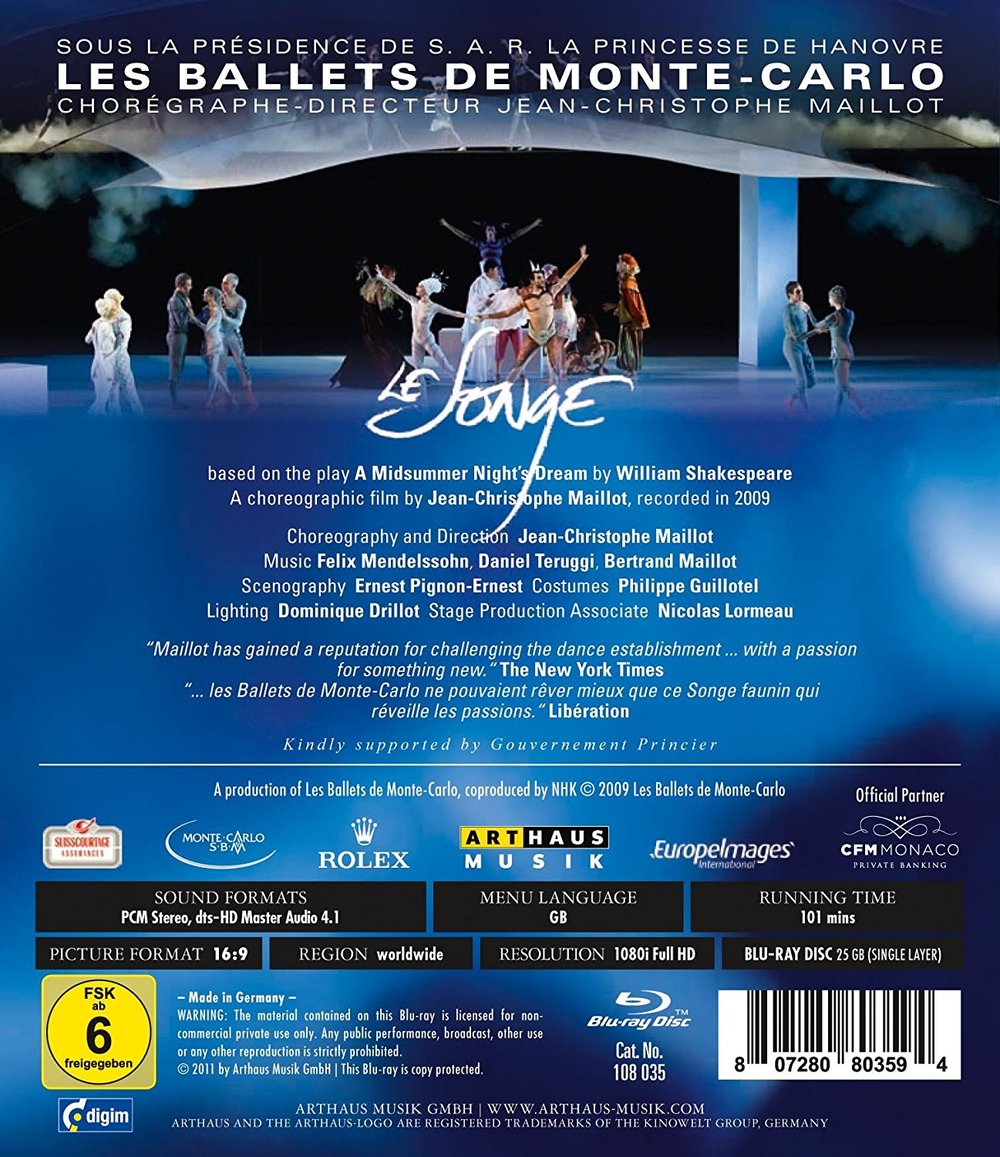

Le Songe ballet, a modern version of Shakespeare's A Midsummer Night's Dream choreographed and directed by Jean-Christophe Maillot. Uses the famous music by Felix Mendelssohn mixed in with wild modern scores from Daniel Teruggi and Bertrand Maillot. It's called a "choreographic film" and was recorded in 2008 as performed by Les Ballets De Monte-Carlo at the Grimaldi Forum Monaco. Neither the disc package nor the keepcase booklet identifies the dancers and their roles. I believe the dancers are Bernice Coppieters, Jérôme Marchand, Jeroen Verbruggen, Anjara Ballesteros, Sarad Jane Medley, Jens Weber, Cyril Bréant, April Ball, Nathalie Nordquist, Asier Uriagereka, Julien Bancillon, Gioia Masala, Gaétan Morlotti, Oliver Lucea, Chris Roelandt, Ramon Gomes Reis, Rodolphe Lucas, Maude Sabourin, Sivan Blitzova, Francesca Dolci, Elodie Puna, Lisa Jones, Quinn Pendelton, Carolyn Rose, Jennifer Brie, and Katarzyna Kucharska. Scenography by Ernest Pignon-Ernest; costumes by Philippe Guillotel; lighting by Dominique Drillot; stage production associate was Nicolas Lormeau. Nothing has been published about who gets credit for actually making the video recording of this. Released 2011, disc has 4.1 dts-HT Master Audio sound. Grade: B+
Maillot seems to view his choreography as an ensemble piece; all the dancers in his small company are great. The video is pretty and sharp even though the design has a black background and a lot of shadows. No credits are given for an orchestra, so I assume there was never live music with this show. The Mendelssohn music is mediocre; the modern music sounds terrific.
Maillot does a remarkably good job of dealing with most of the elements of Shakespeare's complicated play including the play within the play (now play within the ballet) performed by the "rude mechanicals." Maillot tries hard to help out by color-coding the main characters (so you know which girl is supposed to wind up with which guy) and putting their names in big letters on their costumes. If you know the play you will probably find it fairly easy to follow the ballet libretto. If you don't know the play, this show will likely be confusing. Arthaus provides a plot summary that is too vague, but there is a synopsis (keyed somewhat inaccurately to the chapter numbers on the disc) that may help a bit. If you're really interested in the plot of MSND, try our outline of the Shakespeare play.
The actors in the play within the ballet wear costumes that identify their trades as assigned by Shakespeare. They are all dancers, I think; but with one exception, they don't dance. They play the parts of amateur thespians by speaking and singing in French, in English with heavy French accents, and sometimes in English I can understand. (There are no subtitles, but you really don't need them.) The one actor who dances is Bottom. You will recall he gets turned into an ass. Titania is then tricked into hitting on him, and this scene requires dancing for sure.
According to the keep case booklet, Maillot's "personal inward quest is the origin of a new language that enables him to approach the great classics and to establish his mark in the world of abstraction." What they are talking about here is Maillot's aggressive updating in design and direction. This dream does not take place in the William Shakespeare National Forest. It takes place in the Sigmund Freud Forest of Ferral Phantacies. Oberon is some kind of satyr. Titania is the most lascivious royal since Potipher's wife. The ever gleefully hyperactive Puck is a symbol of the male orgasm that newer ends. The "page" that Oberon and Titiania fight over is a female Puck who is ready to be plucked—I call her Puckette. Titania's nubile fairies look like honorary pall-bearers at Hugh Heffner's funeral. Put all this sex together with Maillot's use of curious costumes, surreal scenery, and hyperactive dance moves and you have a great show if you like this sort of thing. (If you want something tamer, we also have a traditional version of this ballet performed by the Pacific Northwest Ballet and a recording of the Mendelssohn music to MSND from the Japanese Mito Chamber Orchestra conducted by Seiji Ozawa.)
Are you ready for some screenshots? Here's one from an opening scene. In the background stands the Duke of Athens with Hippolyta, Queen of the Amazons. They are to be married in 3 days. A group of working stiffs in the foreground are planning to produce a play to entertain the royal newlyweds. Carpenter with his (her in this case) right-angle tool is the leader of this band of "poor players." This gives men in the company something to do—they are surprisingly good at physical comedy and they also speak and sing:
Maillot has color coded and named the young lovers so you keep things straight. Behind them you see Bottom, the tailor:
Hermia pleads with the Duke not to make her marry Demetrius as her father has commanded. The kindly Duke gives her options: Demetrious or death:
In Freud's forest lives Oberan the King of the forest spirits. Puck is his favorite retainer:
Oberon has a magic flower that can make people fall in love. The flower is mounted on a Segway scooter to increase mobility and firepower. Here Lysander gets the treatment by mistake:
Oberon mostly uses the flower to find new partners for himself. But he does have a Queen, Titania, who is his favorite much of the time. I picked this long-range shot of Oberon and Titania to give you a view of the whole stage:
Oberon and Titania are constantly stoking:
Titania's retinue of sexy fairies are constantly gyrating and cavorting, usually in slow motion. The creature in white would be the Indian Boy in the Shakespeare play. He has morphed into Puckette:
Oberon shows more interest in Puckette that he ought to, leading to strife with Titania:
The fairies gang up on Puck:
Oberan tricks Titania into falling in love with Bottom, whom Puck has disguised as an ass (his arms have turned into ears of the ass):
But soon Oberan and Titania reconcile and mate:
In the background on another stage, Puck and Puckette are imitating all the moves of their master and mistress:
Then Puck attends to the mating of the young humans:
Just as in the play, there's no mass wedding scene (or famous Mendelssohn wedding march music). But suddenly we are at the party for 3 new sets of spouses and it's time for the play, Pyramus and Thisby (with its dual satire on Ovid and English yokels). Alas, Pyramus and Thisby don't get to mate—they die along with everybody else except the moon.
View from backstage:
The director was hoping for applause and a tip. But Theseus and Hippolyta are already on the way to their bed, and the rest of the audience has fallen asleep:
OR




















